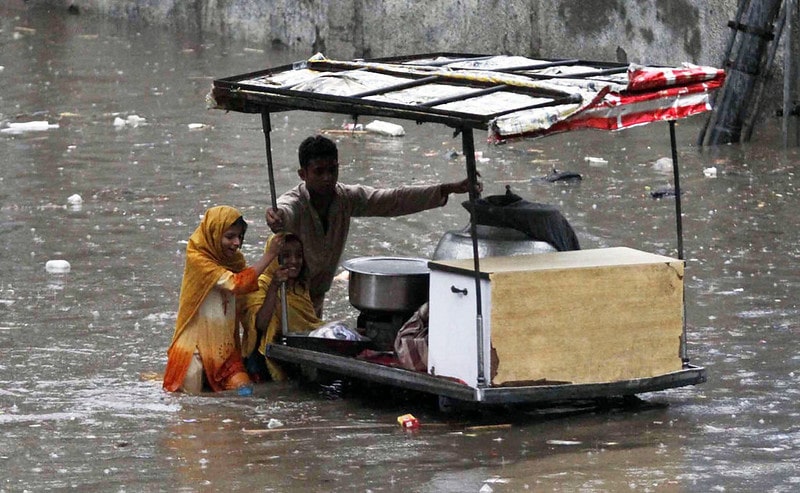In a Lancet review, experts have warned that unless urgent global action is taken to tackle the advancing climate crisis, there will be more frequent and harmful health emergencies in the near future. They stress the need to tackle climate change in the context of the impacts of, and the global response to, the COVID-19 pandemic.
—
The 2020 Lancet Countdown tracks 43 indicators across five sections: climate change impacts, exposures, and vulnerabilities; adaptation, planning, and resilience for health; mitigation actions and health co-benefits; economics and finance; and public and political engagement. The report represents the findings and consensus of 35 academic institutions and UN agencies, and draws on the expertise of climate scientists, geographers, engineers, experts in energy, food, and transport, economists, social, and political scientists, data scientists, public health professionals and doctors.
Here are the six main takeaways from the report.
- Every country will suffer from the impacts of climate change, poorer nations more so than wealthier ones
“No country is immune from the health impacts of worsening climate change,” the authors write. During the last 20 years, there has been a nearly 54% increase in heat-related deaths in people older than 65 years. Globally, in 2019, vulnerable populations were exposed to an additional 475 million heatwave events. This resulted in a cumulative 302 billion hours of potential labour capacity lost in 2019. Regarding wildfires, since the 2000s, nearly 128 countries have experienced an increase in the number of people exposed to wildfires, with the US ranking among the highest. By 2100, 565 million people will be displaced by sea-level rise. Additionally, global food security is threatened by rising temperatures and increases in the frequency of extreme weather events; global yield potential for major crops declined by 1.8-5.6% between 1981 and 2019.
Finally, the climate suitability for infectious disease transmission has been growing rapidly since the 1950s, with a 150% increase for dengue in 2018, and regional increases for malaria and Vibrio bacteria. Overall, 67% of global cities surveyed expected climate change to seriously compromise their public health assets and infrastructure.
Thankfully, changes for national health systems to adapt is underway. Health services in 86 countries are now connected with their equivalent meteorological services to assist in health adaptation planning, while at least 51 countries have developed plans for national health adaptation, and global spending in health adaptation rose to 5.3% of all adaptation spending in 2018–19, reaching US$18·4 billion in 2019. Similarly, least-developed countries and small island developing states are providing increasing global leadership within the UN General Debate on the connections between health and climate change.
- The degradation of nature is driving ecological breakdown and the spread of zoonotic diseases
The researchers write, “The climate emergency and COVID-19, a zoonotic disease, are both borne of human activity that has led to environmental degradation. Neither the climate emergency nor a zoonotic pandemic were unexpected.”
The factors that drive the emergence of zoonotic diseases – such as intensive farming, the international trade of exotic animals, destruction of wildlife habitats, unsustainable urbanisation – also come with stresses on our health systems, climate change, global food security and air pollution.
While global spending trends have shown promise in recent years for health and health-related adaptation, governments remain unable to fully implement their plans for national health adaptation. The report emphasises the need to strengthen underlying health systems and create “multisectoral alignment” to protect human health, particularly for the most vulnerable populations.
COVID-19 has dramatically altered the pattern of health-care demand, with health systems quite literally restructuring services overnight. As governments continue to respond to the public health and economic effects of the pandemic, it is important to align these priorities and ensure that enhanced preparedness for future pandemics also grants an increased capacity to tackle climate change.
You might also like: How Digital Agriculture Can Ease Land Use, Water Woes
- Health and climate must be seen as interrelated
The report urges governments to see health and climate as interrelated risks, saying, “Treating these resultant health conditions effectively depends on health systems’ capacity, which is in turn dependent on the resilience of health services that are increasingly stretched in response to the two crises.”
During 2019, there was concerning progress in numerous sectors including a continued failure to reduce the carbon intensity of the global energy system, an increase in the use of coal-fired power, and a rise in agricultural emissions and premature deaths from excess red meat consumption. These issues are in part counteracted by the growth of renewable energy and improvements in low-carbon transport. Although the use of these greener options continues to rise at a pace, it is important to consider that they are starting from a low baseline.
Ensuring that the recovery from the pandemic is synergistic with the long-term public health imperative of responding to climate change will be vital in the coming years.
- The world must invest in mitigation and adaptation technologies to tackle climate change
The report warns governments not to use the pandemic as an excuse not to pay attention to the climate crisis. The experts say, “as governments embark on economic recovery plans in the wake of COVID-19, concerns for climate change and equity are rightly focused on a green recovery. Decisions being made now must tackle both crises together to ensure the most effective response to each.”
The report specifically emphasises that governments should invest more in renewable energy while divesting from fossil fuels. In fact, as governments around the world grapple with the challenge of restarting their economies, ensuring that these efforts are aligned with the response to tackle climate change is important.
According to the report, investments to “bend the curve” from the world’s current path and limit warming to 1·5°C by 2100 would generate a net global benefit of USD$264–610 trillion (up to 7 times the size of the global economy in 2018).
In 2019, 236 climate-related extreme events were recorded, with absolute economic losses totalling $132 billion. Although most of these losses occurred in high-income economies, when normalised by GDP, the value of total economic losses in low-income countries was nearly five times greater. Fortunately, when normalised by GDP, relative economic losses have been decreasing as the number of total extreme events has been increasing, suggesting that adaptation and prevention are reducing the impacts of these events.
Thankfully, investment in new coal capacity has been declining since 2011 and decreased by 6% between 2018 and 2019. However, despite this reduction, global coal capacity continues to increase, with fewer retirements than additions of coal plants for every year tracked. Phasing out coal is vital, not only to tackle and mitigate climate change, but also to reduce premature deaths due to air pollution.
Since 2016, investment in global energy supply and efficiency has hovered at just less than $1.9 trillion, with fossil fuel supply consistently accounting for around half this value and all renewables and energy efficiency combined maintaining a share of 32%. To be consistent with 1.5°C of warming this century, annual investments must increase to $4.3 trillion by 2030, with investment in renewable electricity, electricity networks and storage and energy efficiency accounting for at least half this value.
Importantly, governments need to put a price on emissions. However, not all countries explicitly set carbon prices, and in some cases, the strength of any carbon price could be undermined by the opposing influence of subsidies on fossil fuel production and consumption.
- The media is very influential in shaping the climate change debate
Public and political engagement is essential to curb fossil fuel consumption. The report shows that engagement with health and climate change is continuously increasing. Between 2007 and 2019, newspaper coverage on climate change increased by more than 50% and scientific journal output increased by more than 500%. Across 2018 and 2019, the proportion of Wikipedia users searching for articles that linked health and climate change also increased.
Additionally, media coverage increased at times of heightened political and public engagement. As captured by Wikipedia use, there was a spike in individual engagement in health and climate change in September, 2019, coinciding with Greta Thunberg’s speech at the UN Climate Action Summit.
However, inequalities in wealth and political influence exist. For example, in both the UN General Debate and the NDCs, engagement in health and climate change is led by countries and regions that are affected most by the changing climate to which they have contributed the least. At the same time, the science of health and climate change continues to be led by high-income, high-emitting countries, which are mainly responsible for climate change.
Unfortunately, little attention is paid to the health impacts of climate change.One-sixth of newspaper articles on climate change discuss its health dimensions, while less than one-tenth of scientific articles do so, as do less than a quarter of health-care companies signed up to sustainable business practices. Politically, health and climate change are rarely connected by government leaders in their speeches at UN forums.
Despite the fact that underlying inequalities in the drivers and effects of climate change remain, there is evidence that health is becoming increasingly central to public and political engagement.
- Shifting to low-carbon diets is essential to a sustainable future
Food production represents 25% of global greenhouse gas emissions, while 9 million annual deaths are linked to poor diets. In this context, the report emphasises that a large part of the climate and health response is to encourage a shift to low-carbon diets, mostly by consuming less meat and dairy products. The researchers say that adopting such diets will help achieve a sustainable recovery that tackles both the climate and health crises.
Featured image by: Flickr

















